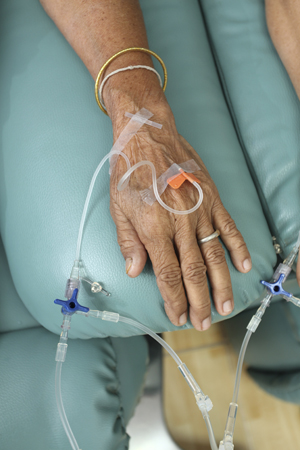
Improved imaging techniques for tumor blood vessel networks will help improve the targeting of intravenous chemotherapy.
© BluePlanetEarth/iStock/Thinkstock
Being able to view tumor blood vessels without surgery or potent dyes can improve our understanding of the environment in which a tumor grows. Now, a team of researchers, including Chang-Tong Yang from the A*STAR Singapore Bioimaging Consortium, have developed a contrast agent that selectively labels the tumor blood vessel network for use in noninvasive tumor imaging studies.
Assessing the extent of the blood vessel network within a tumor enables doctors to determine how far along the cancer has progressed and to predict whether a tumor will respond to intravenous chemotherapy drugs through modeling the drug’s potential path and absorbance. While noninvasive imaging techniques can help visualize all blood vessels in patients, visualizing the blood vessels of a tumor requires a contrast agent that can selectively label the tumor vessels. Such substances concentrate within tumors by binding to molecules that are more prevalent in tumors than in normal tissues.
The researchers developed a contrast agent called Gd(DO3A-Lys) that has an optimal half-life, meaning it persists in the blood long enough to be useful as an imaging aid. Contrast agents that strongly bind blood albumin increase the visibility of large blood vessels and are already in clinical use, explains research co-leader Edward George Robins. However, Gd(DO3A-Lys) only weakly binds albumin, enabling the contrast agent to specifically target and visualize areas that contain tumors and their microvasculature.
Contrast agents eventually leave the body when filtered through the kidneys. Promisingly, the researchers were able to show that Gd(DO3A-Lys) has low toxicity to kidney cells growing in culture. In addition, mice given a single dose of Gd(DO3A-Lys) showed no kidney toxicity at both low and high doses, although the high-dose treatment did result in some damage to the liver — the organ responsible for breaking down drugs.
After administering Gd(DO3A-Lys) to tumor-bearing mice, Yang and colleagues used contrast-enhanced magnetic resonance imaging (CE-MRI) to demonstrate that the contrast agent selectively localized to the site of the tumor. Importantly, as only a minimal amount leaked from the blood vessels into the tumor itself, Gd(DO3A-Lys) appeared to be retained within the tumor’s blood vessel network, allowing the fine structures of the tumor vessels to be clearly imaged.
While the team’s results are encouraging, clinical use of Gd(DO3A-Lys) is still a long way off. Further study is needed to assess the sensitivity of Gd(DO3A-Lys) to detect changes in the tumor vasculature and potential interactions with tumor treatments such as anti-angiogenesis drugs.
The A*STAR-affiliated researchers contributing to this research are from the Singapore Bioimaging Consortium and Institute of Chemical and Engineering Sciences.



